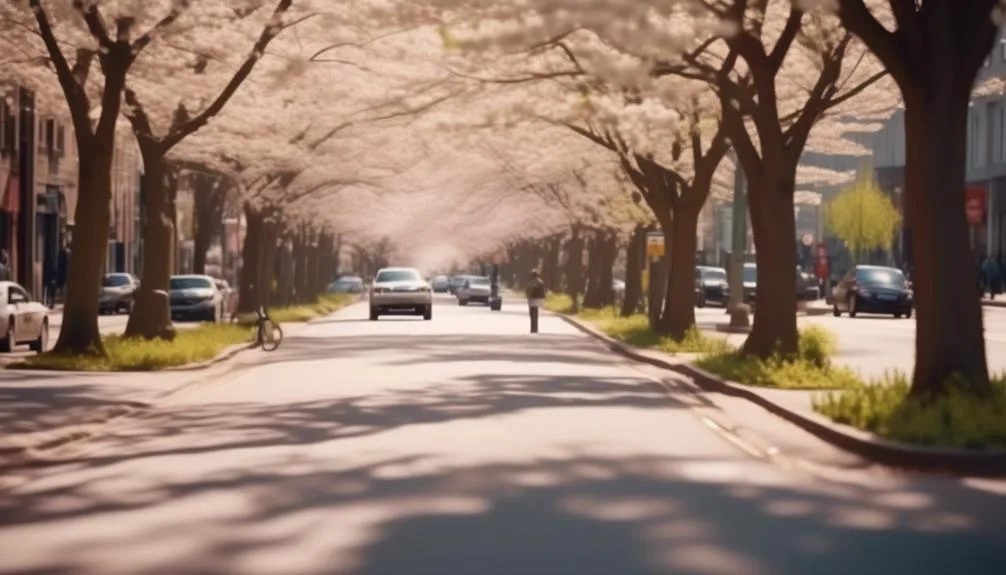Selecting the right trees for city streets is crucial. Dogwood trees present a complex choice due to various factors like their ability to thrive in urban settings and their visual appeal.
Before deciding on using dogwood trees for street planting, it's essential to weigh their pros and cons. Are they sturdy enough for city environments? Do they provide ample shade and enhance the overall beauty of the streets?
Let's dig into these questions to uncover the best options for urban green spaces.
Suitable Conditions for Street Planting
When selecting dogwood trees for street planting, it's crucial to consider the suitable conditions to ensure their growth and longevity. In the urban environment, tree selection must prioritize species that can thrive amidst pollution, compacted soil, and limited space.
Dogwood trees are well-suited for urban planting due to their adaptability and resilience. However, it's essential to assess the soil quality before planting along sidewalks. Dogwoods prefer well-draining soil with adequate moisture and nutrients.
Additionally, the proximity to sidewalks requires consideration to avoid root damage and infrastructure issues. Proper soil preparation and ongoing maintenance are vital for the successful growth of dogwood trees in street environments.
Benefits of Dogwood Trees for Urban Areas
Dogwood trees offer numerous benefits to urban areas. They are able to thrive in challenging environments, making them a valuable addition to city landscapes. The vibrant blooms of dogwood trees enhance urban beautification, adding aesthetic appeal and creating a welcoming atmosphere for residents and visitors.
In addition to their visual appeal, dogwood trees provide important environmental benefits. They improve air quality and support urban biodiversity. By mitigating the urban heat island effect, these trees provide shade and help reduce overall temperatures in built-up areas.
Furthermore, dogwood trees contribute to public safety and tree health. They attract beneficial insects and support a balanced ecosystem. Their resilience and low maintenance needs make them an excellent choice for enhancing the urban landscape while promoting environmental sustainability.
Potential Challenges of Street Planting With Dogwood Trees
Growing dogwood trees in urban settings presents several challenges that require careful consideration and planning to ensure their successful establishment and long-term health. When planting dogwood trees along city streets, you may encounter the following potential challenges:
- Urban Pollution:
- Dogwood trees are sensitive to air pollution, which is often more concentrated in urban areas.
- High levels of pollutants can stress the trees, leading to leaf damage and overall reduced vitality.
- Tree Root Conflicts:
- In urban settings, limited space and competition from underground utilities can restrict the spread of dogwood tree roots.
- This can hinder their ability to access necessary water and nutrients, impacting their growth and health.
- Maintenance:
- Urban environments may require more frequent maintenance to mitigate the effects of pollution and manage tree root conflicts.
- This adds to the overall cost and effort of street planting with dogwood trees.
Maintenance Considerations for Dogwood Trees in Urban Settings
Considering the unique challenges of urban environments, maintaining the health and vitality of dogwood trees in city settings requires proactive and consistent care.
When it comes to pruning techniques, it's essential to regularly inspect the trees for dead or diseased branches and promptly remove them to prevent the spread of disease and maintain the tree's overall health. Additionally, proper pruning can help shape the tree and promote optimal growth.
As for watering schedules, especially in urban settings where soil can be compacted and less permeable, it's crucial to ensure that the trees receive an adequate amount of water. Deep, infrequent watering is generally recommended to encourage deep root growth and overall tree resilience.
Best Practices for Successful Street Planting With Dogwood Trees
To ensure the successful street planting of dogwood trees, it's important to apply proactive maintenance practices that support their health and vitality in urban environments.
- Tree Selection and Spacing: Choose dogwood tree species that are well-suited for urban settings, such as the Kousa dogwood, and ensure proper spacing between trees to prevent overcrowding and competition for resources.
- Root Management: Implement root management techniques to prevent damage to sidewalks and roads. Consider using root barriers or structural soils to direct root growth away from infrastructure.
- Pruning: Regularly prune dogwood trees to maintain their shape, remove dead or diseased branches, and promote healthy growth. Proper pruning also helps to ensure adequate clearance for pedestrians and vehicles.
Conclusion
In summary, when considering street planting, dogwood trees can thrive with suitable conditions and proper care. Their contribution to urban areas is significant, but it's essential to anticipate and address potential challenges.
By adhering to best practices, dogwood trees can enrich the beauty and environmental well-being of city streets. These considerations are pivotal in determining the viability of planting dogwood trees in urban settings, ensuring a harmonious balance between nature and urban life.

My interest in trees started when I first saw the giant sequoias in Yosemite.
I was a teenager then, and I remember thinking, “I need to learn more about this.”
That moment stuck with me.
A few years later, I went on to study forestry at Michigan Tech.
Since graduating, I’ve worked in a mix of hands-on tree care and community education.
I’ve spent over ten years helping people understand how to plant, maintain, and protect the trees in their neighborhoods.
I don’t see trees as just part of the landscape.
They are living things that make a real difference in our daily lives.
